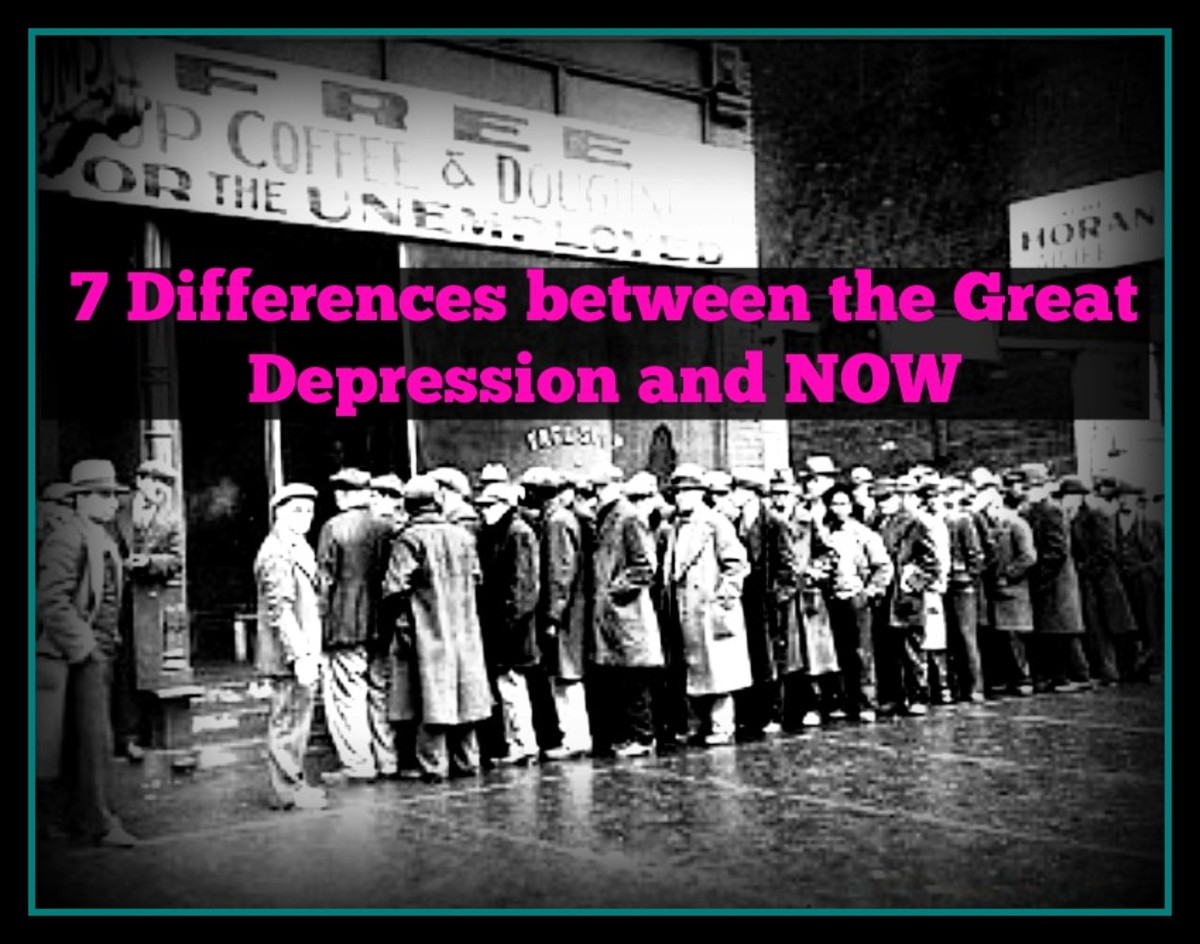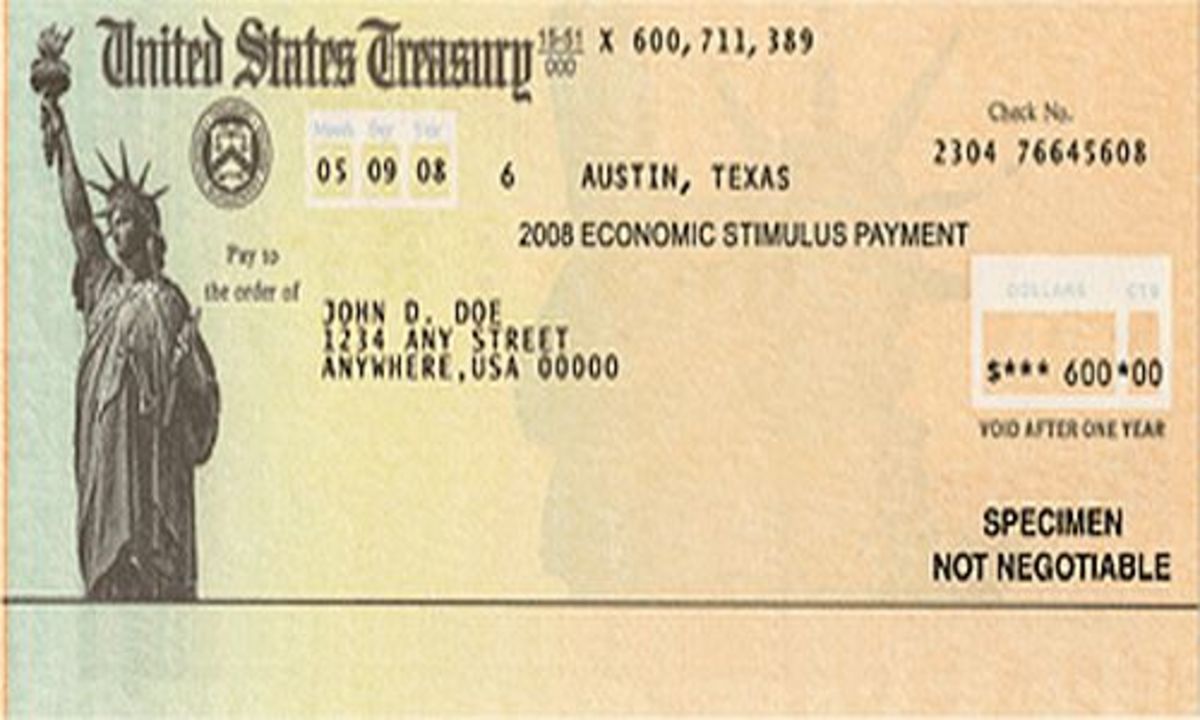The Causes Of The 2008 Financial Meltdown And The Reforms Enacted - Are They Enough?
The Causes Of The 2008 Financial Meltdown
The 2008 financial meltdown was the worst economic crisis for the United States since the stock market crash of 1929 and the subsequent Great Depression. The root of the problem resided in the collapse of the housing market. There were several other factors that also contributed or exacerbated the problem. Democrats and Republicans point fingers at different issues as the causes of the meltdown. The issues they choose to stress are selected to implicate the other party more heavily as being responsible for causing it. Most politicians have not examined this financial fiasco in its entirety with an unjaundiced eye. I have attempted to do so in this article and have identified eight major causes for the meltdown. None of these causes on its own was responsible for causing it. Even combining a few together would not have sparked the slide. All of them building upon one another created a toxic brew that tumbled this house of cards. The whole economy was soon brought to the brink of ruin.
I will describe in this Hub two groups of causes. The first group entails three causes that set the foundation from which the housing bubble could develop and grow. The next group of five causes were the engine that drove the home mortgage market out of control and finally off the cliff. Finally I will examine the steps that have been taken to alleviate these causes as well as the steps still needed to be taken to ensure that this debacle never reoccurs. This is vital to the U.S. taxpayer since he and she are always on the hook for the bill to clean up any financial mess of this magnitude.
Let us first turn back to the 1990s to discover the root causes of the financial meltdown. The first cause was the repeal of the main aspects of the Glass-Steagall Act. This law was enacted in 1933 in response to the massive bank failures that occurred after the stock market crash of 1929. The main purpose of the act was to shield the deposits of bank customers from investment risk. Commercial depository banks and investment banks were now to be totally separate entities. This arrangement worked very well for the U.S. throughout the subsequent years. Steady growth with no major financial calamities held sway in the markets. The banking industry did begin lobbying for the easing or eliminating of this separation in the 1980s due to increased international competition. The 1994 election brought Republican majorities to both houses of Congress. This led to a more accommodative Clinton Administration on many issues including loosening regulations on industry. Federal Reserve Chairman Alan Greenspan was a supreme proponent of freeing up industry from regulations also. This confluence of political factors paved the way for the banking industry to have their prayers answered with the repeal of most of the Glass-Steagall Act in 1999. Commercial banks were now free to invest their own funds as well as owning their own investment bank units for the benefit of their clients. This was the first step towards greasing the skids for increased risky trading.
The next move that further increased risks was the decision to greatly encourage home ownership levels by way of the Fannie Mae and Freddie Mac companies. The Federal National Mortgage Association (FNMA) was created as a government agency in 1938 to provide banks with funds for home loans. The purpose was to facilitate a fluid market and create stability in the system. It was also created to increase affordable housing. FNMA was converted into a publicly held company in 1968 but was and is still a government sponsored enterprise. FNMA was further authorized to purchase private mortgages not already insured by other federal agencies. The Federal Home Loan Mortgage Corporation, also known as Freddie Mac, was created in 1970 to handle this function as well as to compete with Fannie Mae. President George H.W. Bush signed the Housing and Community Development Act in 1992. This act was created to amend the charters of Fannie Mae and Freddie Mac to encourage low and moderate income housing. The Clinton Administration further pressed these companies to emphasize these mandates in 1999. This renewed emphasis soon led to higher risk loans and relaxed credit standards.
A third factor that paved the way and fueled the financial meltdown was the reaction of the Federal Reserve to the 9/11 terrorist attacks. The United States population was understandably fearful and confused after the attacks. The stock market fell sharply and it was unclear how far the economy might sink. Fed Chairman Greenspan rightfully decided to lower interest rates to keep the economy from crashing. The strategy worked and the economy soon steadied and began growing again in 2002. Unfortunately Greenspan and the Fed kept the rates tremendously low for far too long. Easy money was now awash in the country and needing to be put to work. Interest rates were not significantly raised again until 2006 when the Fed was headed by Ben Bernanke. This was done to stem inflation from growing out of control. The foundation for the overheated housing market was now in place.
Let us now turn to the mismanaged elements of the home mortgage market that most immediately caused this house of cards to crumble. Financial institutions now recognized that huge profits could be made by packaging new mortgages into a security and then selling it. The housing and stock markets were growing at unprecedented levels and profits appeared limitless. The Government National Mortgage Association (GNMA) which is a government agency, had been packaging mortgages into securities and then selling them for many years. The purpose of this was to create a more fluid home mortgage market. Financial institutions now entered into this market in a big way. They not only decided to enter it but they shunned selling only this "vanilla" variety of securities. instead they spiced it up so they could reap even greater profits. Packaged mortgage securities have a beneficial purpose for the home mortgage market by diversifying risks of foreclosure among several financial institutions. This also encourages more lending due to the decreased risk for any one institution. Problems soon arose. These mortgage securities began to create an insatiable appetite for new mortgages. Soon countless mortgage lending companies sprang up all over the country to cash in on this phenomenon.
The problem was that most states had little or no regulations in regards to them. Therefore these companies could sell home mortgages with very little concern as to the creditworthiness of the home buyer because they would be passing the mortgage on to other financial institutions. They received large fees for this service with little or no risk. This led them to develop creative loans that would allow poorer customers the ability to obtain home loans that they could afford though only initially. The monthly mortgages would be affordable for the first few years but they would adjust much higher especially if interest rates rose. The mortgage lenders rarely disclosed the terms clearly to these unsophisticated borrowers. The theory behind these loans was that the borrowers would be able to sell the home before the mortgages adjusted higher and make a profit on their home due to the constantly rising home prices. These customers could not qualify for an ordinary mortgage due to their lack of adequate income, collateral, and down payment. The mortgage lenders now could profit from an expanded pool of borrowers. Both government regulatory agencies and financial institutions that traded mortgage securities turned a blind eye to this practice so as not to kill the mortgage security "gravy train".
The next culprits in this debacle are the credit ratings companies. These companies such as Standard & Poors and Moodys were well respected conservative organizations. Unfortunately their revenues increasingly became dependent on retaining as clients the institutions whose financial instruments they rated. This occurred just as the proliferation of these mortgage securities exploded both in quantity and complexity. They were becoming increasingly specialized. The highest quality mortgages were being placed in one type of security while the highest risk mortgages were placed in others. There were many different grades of mortgages in between. Credit ratings companies began to cut corners because of the need to retain clients and due to the fact that they simply did not understand all the intricacies contained within many of these securities. Most of these securities were simply rated AAA no matter what the quality was of the mortgages that were contained within the security. Investors relied on these ratings and were now being misinformed.
The next factor that accelerated the crash and exponentially increased the complexity and confusion of the market were the dreaded derivatives. The specific derivative involved with the mortgage security market was the Collateralized Debt Obligation or CDO. A CDO is basically an insurance policy that hedges the risk of the mortgage securities on to a third party. The result of this practice was a housing market feeling ever more secure and complacent. The sky seemed to be the limit for the housing market and there was now an insurance instrument if it failed. A further complication was the complexity of these CDO's. Very few people understood their contents and there was a very thin trading market for them. No one knew what these CDO's were truly worth until they were sold. This created a ticking time bomb if the housing market fell precipitously. AIG and then the American taxpayer would discover this beginning in 2008 when the market fell. AIG was the prime issuer of these CDO's. They would have to pay out to the holders of these CDO's when the housing market crashed to the tune of many billions of dollars. AIG became insolvent and was unable to pay out on this seemingly endless wave of claims. They owed so much that it threatened to take the entire financial system down. The U.S. government and thus the American taxpayer took them over in 2008 to prevent this from happening.
This leads me to the final and most overwhelmingly critical factor causing this financial meltdown. It was the total neglect and failure of the risk management functions in all government regulatory agencies and financial institutions involved in the housing market. The runaway rise in home prices and the stock market between 2002 and 2008 led to complacency in these organizations. Very few leaders thought this run up would end any time soon. Complex financial instruments seemingly insured a back stop against any downturn.
Unfortunately no one fully understood what was contained within those instruments. Even fewer people saw what was going on with the entire housing picture as I have outlined it. They would have seen the fragility of the entire structure if they had bothered to do their full due diligence. All government regulatory agencies missed it either through incompetency or apathy. Financial institution risk managers only saw massive profits and ignored any red flags lest they potentially lessen any of their profits. Finally interest rates were raised beginning in 2006. Home prices began falling the next year. Mortgage security mutual funds began to fail in 2007. The financial institutions themselves began to fail in early 2008. The rest is history.
What has been done since this catastrophe occurred to mitigate these problems? What still needs to be done? The Dodd-Frank Wall Street Reform and Consumer Protection Act passed in 2010 addresses many of these issues. The Glass-Steagall repeal was allowed to stand in this act but an important restriction was imposed. Banks are now limited to investing only up to 3% of their Tier I capital thus greatly limiting their risk. I believe this is sensible and saves the banks from themselves. I also feel that they should keep clear divisions between their commercial banking and investment banking businesses. This was not addressed in the Act but I believe it should be imposed to limit the risk that they put on their commercial banking customers.
The Obama Administration has proposed some possible new changes for Fannie Mae and Freddie Mac. The most extreme of the proposals would probably phase out the two agencies over time. The proposal would gradually withdraw them from funding home loans altogether. Instead they propose having groups of lenders and investors taking on this role. I feel that this is an ill-advised proposal. For years these two companies played a vital role in fostering new home ownership. Only after unwise government prodding to loosen loan standards did the system begin to implode. They conduct a legitimate function in maintaining a fluid home loan market. The only change I would like to see is legislation mandating that they maintain proper and sound credit requirements. The Dodd-Frank Reform Act requires this of financial institutions. Why not simply require the same of Fannie Mae and Freddie Mac?
There is not a lot that can be done about the Federal Reserve keeping interest rates too low for too long. The Fed is independent and should remain so to keep them immune from the political winds. They depend on their collective experience and knowledge of the financial markets and economics to make the right calls in these situations. Hopefully Fed officials have learned this lesson and will tighten their policies at the proper times.
The Dodd-Frank Wall Street Reform and Consumer Protection Act also addresses the factors that relate directly to the home mortgage market and does so in excellent fashion. As I stated earlier in this article, mortgage backed securities serve a sound purpose in maintaining the liquidity of the home mortgage market. This reform act thankfully leaves this largely intact but strengthens oversight. It requires financial institutions to retain at least 5% ownership in the securities they issue. This is a prudent change and ensures that these organizations have "skin in the game" which incentivizes them to maintain proper risk management.
The Mortgage Reform and Anti-Predatory lending section of this new legislation addresses thoroughly the problems of mortgage lending. It establishes minimum standards and requires all mortgage lenders to fully and clearly explain all terms of their home loans. I will not list all the changes but it is fair to say that they have made excellent moves to clean up mortgage lending and have addressed most of my concerns that I wrote about earlier in this article. Additionally I hope that all states will move to pass legislation that will require all mortgage lenders in their respective states to be licensed and properly regulated.
The Dodd-Frank Act also took very impressive steps to clean up the credit ratings company problem. They created an Office of Credit Ratings within the Securities and Exchange Commission (SEC) which will create new rules and have annual reviews of the credit ratings companies. The new rules would mandate these companies rate financial instruments impartially with no improper input or excessive compensation from the issuing institutions. These credit ratings companies will need to fully disclose any pertinent information on all new and revised ratings. The reform act also included a section which will add needed transparency to the derivatives market. They will now be traded either on an exchange or in a clearinghouse. This will allow the trading public and financial institutions to know the value of these derivatives at any given time. An inter-agency government group will be formed to monitor this market.
Finally I would like to address the overarching issue that helped to cause this financial meltdown. It was the disturbing absence of competent risk management in both the financial industry and government. The financial institutions have belatedly reinforced their risk management teams after feeling the intense pain of the 2008 crisis. They appear to be getting the message. Unfortunately they have swung so far in the direction of safety that home loans and loans of all types have slowed to a crawl. I believe this to be ridiculously prudent. Most financial institutions are sitting on a hoard of cash. It is true that the Obama Administration conducted stress tests on them in 2009 and forced them to maintain a higher level of reserves to guard against losses. The cash holdings for most banks are now far above this level. They simply need to return to the loan standards that they maintained before 1999. These were prudent loans as well as being quite profitable.
The Dodd-Frank Wall Street Reform and Consumer Protection Act has set up a new framework for government regulation of the financial markets. The key for government regulators now is to set up proper and efficient rules and enforce them effectively. My call for market vigilance extends to government regulators just as I have for financial institutions. Regulations are only as good as the people who enforce them. They become totally ineffective if government only pays lip service to them. Furthermore all participants in the financial markets must guard against becoming blinded by a bull market and high profits. History lessons must be continually taught, remembered, and reinforced. Financial crashes have occurred throughout our history. The circumstances that cause them change but not the underlying reasons. Hubris, complacency, greed, and incompetency always begin to raise their ugly heads and assert themselves over the financial markets when the participants forget the causes and effects of the previous crash.
We the United States taxpayers must constantly remind our government and financial leaders that we expect their absolute highest vigilance when managing and safeguarding this country's wealth. Ultimately it is we who suffer through a recession or depression and bail the financial markets out. We must demand accountability from all parties. Too many people have suffered exorbitantly as a result of this latest financial meltdown. We the American people must also take responsibility and insist that this never happen again. We are the ultimate guarantors of this system. We can vote our leaders out of office and we can withdraw our money from derelict financial institutions. Pay constant attention to how your money is being handled and watched over. This is the only way we can perform our own risk management over the system and prevent another financial disaster.








